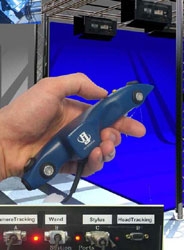 |
William L. Martens: Presentations at the Duesseldorf University of Applied Sciences, 17.5.2001
William L. Martens
Multimedia Systems Lab.
University of Aizu 965-8580
Japan
Dr. William Martens ist ein Wahrnehmungspsychologe
spezialisiert auf Forschung im Bereich des räumlichen Hören und
die Simulation von akustischen Eigenschaften,
welche in der menschlichen Schalllokalisierung benutzt werden.
Er besitzt einige
Patente zu
spatial Schallerzeugungstechnologie und hat veröffentlicht
viele Artikel
zu diesem Thema.
Er trug zu Verbesserungen der räumlichen
Schalltechnologie
für Anwendungen im Konsumerbereich bei,
dazu gehört 3D Positional Audio für die AWE-32
SoundBlaster
Soundkarte für
Creative Labs,
und via Entwicklung von Außenohrübertragungsfunktionen
für
3D RSX,
Intel's spatial sound system.
Dr. Martens ist ein Associate Professor im
Department of Computer Software,
und dem Graduate Department of Information Systems
an der Universität von Aizu
in Aizu-Wakamatsu, Japan.
Whereas the primary motivation in spatial hearing research has been
to gain a greater understanding of the mechanisms of human spatial hearing,
the motivation for applied research has been the verification and
validation of various spatial audio rendering technologies under development.
This paper attempts to outline the uses of misuses of
psychophysical methods typically employed in the subjective evaluation of
spatial sound reproduction. The emphasis is upon the essential tension between
engineering goals and scientific goals, which, while often conflicting,
serve to focus psychophysical research upon resolving disputes between rival
theories of how best to simulate spatial soundfields for the human listener.
A psychophysically-derived control for the perceived range of a virtual
sound source was implemented for the Pioneer Sound Field Controller (PSFC),
a spatial auditory display employing a 15-loudspeaker hemispherical array.
Capable of presenting two independent
sound sources moving within a simulated reverberant environment, the PSFC
primitives include parameters to manipulate source azimuth and elevation,
and also the size and liveness of the simulated space.
As accurate control of virtual source range was confounded by variations
in both the liveness parameter and in overall PSFC channel volume,
an empirical approach was employed to derive a Look-Up Table
inverting the average range estimates obtained from a group of human
subjects listening to a set of virtual sources (short speech samples).
|
 |
